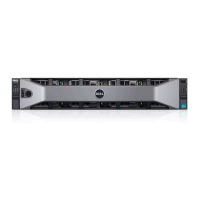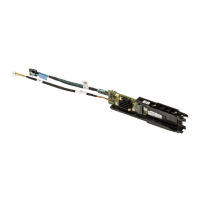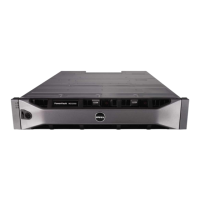Item Indicator, Button, or
Connector
Icon Description
various system level diagnostic or error
information that can be used in troubleshooting
the system. For more information, see the
Integrated Dell Remote Access Controller User’s
Guide at dell.com/esmmanuals.
Diagnostic indicators
The diagnostic indicators on the system front panel display error status during system startup.
NOTE: No diagnostic indicators are lit when the system is turned off. To start the system, plug it into
a working power source and press the power button.
Icon Description Condition Corrective action
Health
indicator
If the system is turned on,
and in good health, the
indicator glows solid blue.
None required.
The indicator blinks amber if
the system is turned on or in
standby, and if any error
exists (for example, a failed
fan or HDD).
See the System Event Log or system
messages for the specific issue. For more
information about error messages, see the
Dell Event and Error Messages Reference
Guide at dell.com/esmmanuals.
Invalid memory configurations can cause
the system to stop responding at startup
without any video output. See the Getting
help section in this document.
HDD
indicator
The indicator blinks amber if
a HDD experiences an error.
See the System Event Log to determine the
HDD that has an error. Run the appropriate
Online Diagnostics test. Restart system and
run embedded diagnostics (ePSA). If the
HDDs are configured in a RAID array, restart
the system and start the host adapter
configuration utility program.
Electrical
indicator
The indicator blinks amber if
the system experiences an
electrical error (for example,
voltage out of range, or a
failed PSU or voltage
regulator).
See the System Event Log or system
messages for the specific issue. If it is
because of a issue with the PSU, check the
LED on the PSU. Reseat the PSU by
removing and reinstalling it. If the issue
persists, see the Getting help section in this
document.
Temperature
indicator
The indicator blinks amber if
the system experiences a
thermal error (for example, a
temperature out of range or
fan failure).
Ensure that none of the following
conditions exist:
• A cooling fan is removed or has failed.
• System cover, cooling shroud, EMI filler
panel, memory-module blank, or back-
filler bracket is removed.
10

